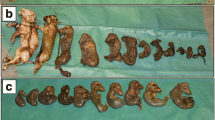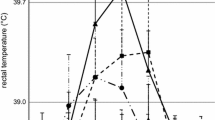Summary
Each of 20 gilts (principals) from a commercial swine herd free of antibody for porcine parvovirus (PPV) was exposed intranasally and orally to PPV at the onset of gestation. The gilts were killed and necropsied 22±1 days later to determine the effect of the virus on their embryos. An equal number of gilts (controls) of the same status, from the same herd, and bred to the same boars, were treated similarly except for exposure to PPV.
The following data were obtained at necropsy and from subsequent laboratory tests. Principals had 223 corpora lutea (8 to 16/gilt) and 203 embryos (6 to 16/litter). Porcine parvovirus-infected embryos (1 to 9/litter) were detected in 12 (60 per cent) of the 20 litters. Of the 203 embryos of principals, 169 were alive and 34 were dead and in various stages of decomposition and resorption. Both virus and viral antigen were detected in 7 of the live embryos (1, 1, 2, and 3 in 4 litters) and in 32 of the dead embryos. With 1 exception, infected live embryos were next to infected dead littermates in the uterus suggesting the beginning of intrauterine spread of the virus. Controls had 234 corpora lutea (9 to 15/gilt) and 217 embryos (9 to 14/litter). None of their embryos were infected with PPV and all but 3 were alive.
Similar content being viewed by others
References
Anderson, L. L.: Growth, protein content and distribution of early porcine embryos. Anat. Rec.190, 143–153 (1978).
Bachmann, P. A., Sheffy, B. E., Vaughan, J. T.: Experimentalin utero infection in fetal pigs with a porcine parvovirus. Infect. Immun.12, 455–460 (1975).
Cartwright, Shella F., Huck, R. A.: Viruses isolated in association with herd infertility, abortions and stillbirths in pigs. Vet. Rec.81, 196–197 (1967).
Cartwright, Sheila F., Lucas, Margaret, Huck, R. A.: A small haemaaglutinating porcine DNA virus. II. Biological and serological studies. J. comp. Pathol.81, 145–155 (1971).
Cropper, M., Dunne, H. W., Leman, A. D., Starkey, A. L., Hoefling, D. C.: Prevalence of antibodies to porcine enteroviruses and porcine parvovirus in body fluids of fetal pigs from small vs large litters. J. Amer. vet. med. Ass.168, 233–235 (1976).
Cutlip, R. C., Mengeling, W. L.: Pathogenesis ofin utero infection of eight- and ten-week-old porcine fetuses with porcine parvovirus. Amer. J. vet. Res.36, 1751–1754 (1975).
Donaldson-Wood, C. R., Joo, H. S., Johnson, R. H.: The effect on reproductive performance of porcine parvovirus infection in a susceptible pig herd. Vet. Rec.100, 237–239 (1977).
Forman, A. J., Lenghaus, C., Hogg, G. G., Hale, C. J.: Association of a parvovirus with an outbreak of foetal death and mummification in pigs. Aust. vet. J.53, 326–329 (1977).
Gillick, J. C.: An outbreak of swine foetal mummification associated with porcine parvovirus. Aust. vet. J.53, 105–106 (1977).
Hogg, G. G., Lenghaus, C., Forman, A. J.: Experimental porcine parvovirus infection of fetal pigs resulting in abortion, histologic lesions, and antibody formation. J. comp. Pathol.87, 539–549 (1977).
Joo, H. S., Donaldson-Wood, C. R., Johnson, R. H.: Observations on the pathogenesis of porcine parvovirus infection. Arch. Virol.51, 123–129 (1976).
Lenghaus, C., Forman, A. J., Hale, C. J.: Experimental infection of 35, 50, and 60-day-old pig fetuses with porcine parvovirus. Aust. vet. J.54, 418–422 (1978).
Lucas, Margaret H., Cartwright, Sheila F., Wrathall, A. E.: Genital infection of pigs with porcine parvovirus. J. comp. Pathol.84, 347–350 (1974).
Mengeling, W. L., Cutlip, R. C.: Pathogenesis ofin utero infection: Experimenta infection of five-week-old porcine fetuses with porcine parvovirus. Amer. J. vet. Res.36, 1173–1177 (1975).
Mengeling, W. L., Cutlip, R. C., Wilson, R. A., Parks, J. B., Marshall, R. F.: Fetal mummification associated with porcine parvovirus infection. J. Amer. vet. Ass.166, 993–995 (1975).
Mengeling, W. L., Cutlip, R. C.: Reproductive disease experimentally induced by exposing pregnant gilts to porcine parvovirus. Amer. J. vet. Res.37, 1393–1400 (1976).
Mengeling, W. L.: Prevalence of porcine parvovirus-induced reproductive failure: An abattoir study. J. Amer. vet. Med. Ass.172, 1291–1294 (1978).
Mengeling, W. L., Cutlip, R. C., Barnett, D.: Porcine parvovirus: Pathogenesis, prevalence and prophylaxis. Proc. Int. Pig Vet. Soc., Zagreb, Yugoslavia, June 1978.
Mengeling, W. L., Brown, T. T., Paul, P. S., Gutekunst, D. E.: Efficacy of an inactivated virus vaccine for prevention of porcine parvovirus-induced reproductive failure. Amer. J. vet. Res.40, 204–207 (1979).
Mengelling, W. L.: Prenatal infection following maternal exposure to porcine parvovirus on either the seventh or fourteenth day of gestation. Canad. J. comp. Med.43, 106–109 (1979).
Morimoto, T., Kurogi, H., Miura, Y., Sugimori, T., Fujisaki, Y.: Isolation of Japanese encephalitis virus and a hemagglutinating DNA virus from the brain of stillborn piglets. Natn. Inst. Anim. Hlth Qt., Tokyo12, 127–136 (1972).
Narita, M. S., Inui, Kawakami, Y., Kitamura, K., Maeda, A.: Histopathological changes of the brain in swine fetuses naturally infected with porcine parvovirus. Bull. Natn. Inst. Anim. Hlth15, 24–28 (1975).
Rodeffer, H. E., Leman, A. D., Dunne, H. W., Cropper, M., Sprecher, D. J.: Reproductive failure in swine associated with maternal seroconversion for porcine parvovirus. J. Amer. vet. Med. Ass.166, 991–992 (1975).
Scofield, A. M.: Embryonic mortality. In:Cole, D. J. A. (ed.), Pig production (Proc. of the Eighteenth Easter School in Agricultural Science, University of Nottingham 1971), 367–383. London: Butterworths 1972.
Wrathall, A. E., Mengeling, W. L.: Effect of porcine parvovirus on development of fertilized pig eggsin vitro. Brit. vet. J.135, 249–253 (1979).
Wrathall, A. E., Mengeling, W. L.: Effect of transferring parvovirus infected fertilized pig eggs into seronegative gilts. Brit. vet. J.135, 255–261 (1979).
Author information
Authors and Affiliations
Additional information
With 3 Figures
Rights and permissions
About this article
Cite this article
Mengeling, W.L., Paul, P.S. & Brown, T.T. Transplacental infection and embryonic death following maternal exposure to porcine parvovirus near the time of conception. Archives of Virology 65, 55–62 (1980). https://doi.org/10.1007/BF01340540
Received:
Accepted:
Issue Date:
DOI: https://doi.org/10.1007/BF01340540




